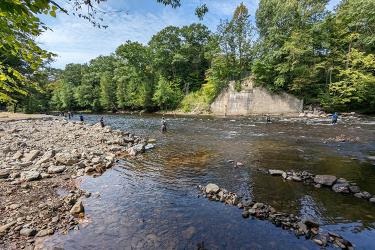It’s the “age-old” story—count the rings in shark vertebrae to estimate the age of a shark, like counting the annual growth rings on a tree stump. Or so shark researchers thought, until 2018. That’s when NOAA shark researcher Lisa Natanson and her colleagues reported that the rings on shark vertebrae are not always deposited annually. Instead, they are driven by changes in length and girth over a shark’s lifetime, the rate of which can change over the years. This meant that the ageing keys for many shark species needed to be revised by developing and validating new methods to determine shark ages.
Enter Michelle Passerotti, a shark biologist in the Apex Predators Program at the Northeast Fisheries Science Center’s Narragansett Laboratory. She is developing techniques to revamp shark ageing and correct age estimates where needed in a new era of ageing.
“Developing new ageing techniques that are more accurate and non-lethal is the ultimate goal,” said Passerotti, “but there are a few steps in that process to get there.”
The first crucial step is making sure new methods will accurately predict shark ages by validating traditionally aged samples.
Radiocarbon Dating for Age Validation
Scientists need accurate reference ages that have been validated against a known timescale to confirm the success of new ageing methods. Validated reference ages also provide the baseline for creating models to estimate shark ages based on non-lethal metrics.
Bomb radiocarbon dating is a technique long-used for validating ages for all kinds of organic matter, including shark vertebrae. Carbon-14, a rare carbon isotope, is absorbed in the calcified tissues of all organisms on Earth. Its prevalence in these tissues tracks environmental fluctuations over time. In the 1950s and 60s, C-14 levels spiked due to nuclear bomb testing, creating a timestamped reference point in all living organisms. Scientists use these timestamps to validate presumed ages from vertebral growth band counts of sharks alive during that time. If the C-14 measured in vertebral growth bands aligns with the timing of the spike in reference chronologies, scientists know that the growth bands were aged correctly.
While a gold-standard for age validation, this method is difficult to apply to sharks caught after about 1980 that were not alive to absorb the C-14 spike. In the past, the small-scale annual changes in environmental C-14 levels that occurred post-bomb were considered too subtle to serve as reference points for validating age. However, recent improvements in chemical analyses now enable ultra-precise measurements that track even minute changes in C-14. This extends the usefulness of C-14 reference chronologies past the bomb spike.
Now, scientists need a shark-specific chronology to validate the ages of modern sharks. Passerotti is working to create this reference chronology by measuring fine-scale changes in C-14 in individual vertebral growth bands of sharks aged 1-2 years old. These sharks can generally be aged accurately with traditional methods.
“My goal,” said Passerotti, “is to create this tool to help validate shark vertebral ages. We didn’t think we could have that level of precision with modern samples, those that were created well after the spike in Carbon-14 caused by atomic testing. But with a modern chronology, we think we can get there.”
Non-Lethal Ageing for the Win
Traditional ageing methods require vertebrae that scientists sample opportunistically from sharks found washed up on shore or from fishery bycatch and landings. As more species are protected, scientists are putting greater emphasis on developing non-lethal ageing methods.
DNA methylation is one method that may allow scientists to predict age using a non-invasive tissue sample taken from a living shark. A type of DNA modification, DNA methylation occurs with age and creates measurable and predictable patterns throughout an organism’s life. By sampling tissues with corresponding validated ages, scientists can train computer models to predict shark ages based on these methylation rates. This may eventually eliminate the need for vertebral samples.
Looking Forward
Validated ages would also improve other emerging methods, such as Fourier-transform near infrared spectroscopy.
With improved, validated ageing methods comes better management of shark populations and overall ecosystem sustainability.
“Age estimation is one of the foundational aspects of fisheries management,” said Passerotti. “Knowing how old fish are and understanding the age structure of a population in general really tells us a lot about the productivity of the population and how much fishing pressure it can sustain.”





